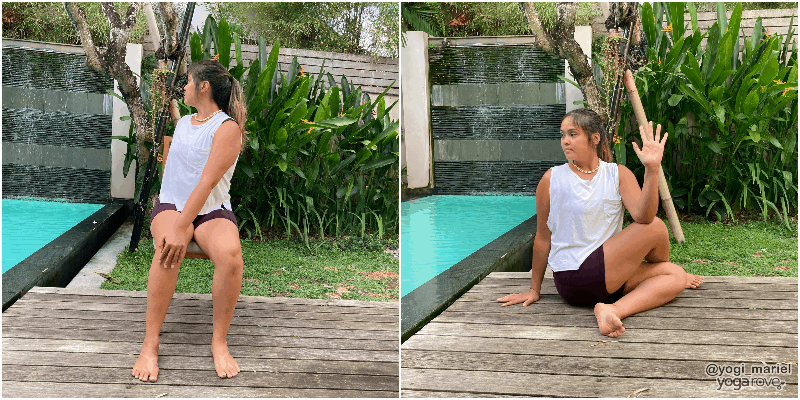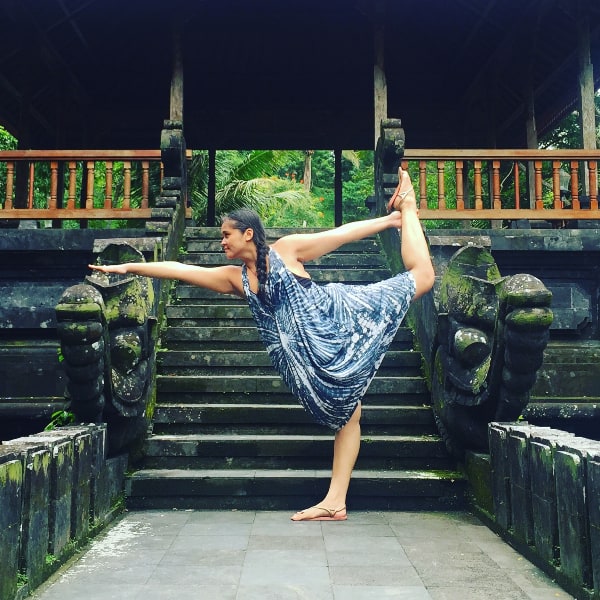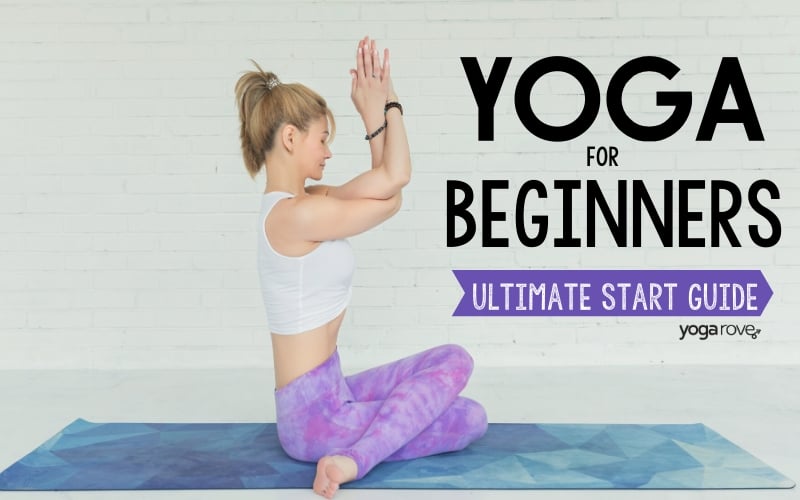This post may contain affiliate links. Please read our disclosure for more info.
Seated spinal twists offer a great sigh of relief at the end of a long work day, during yoga class, or even at your office desk. If you are one of the millions of people stuck at a desk all day, it is not unlikely that you may be suffering from chronic lower back pain, bad posture, and poor spinal mobility. With regular practice, a simple seated spinal twist pose can help you to alleviate these symptoms.
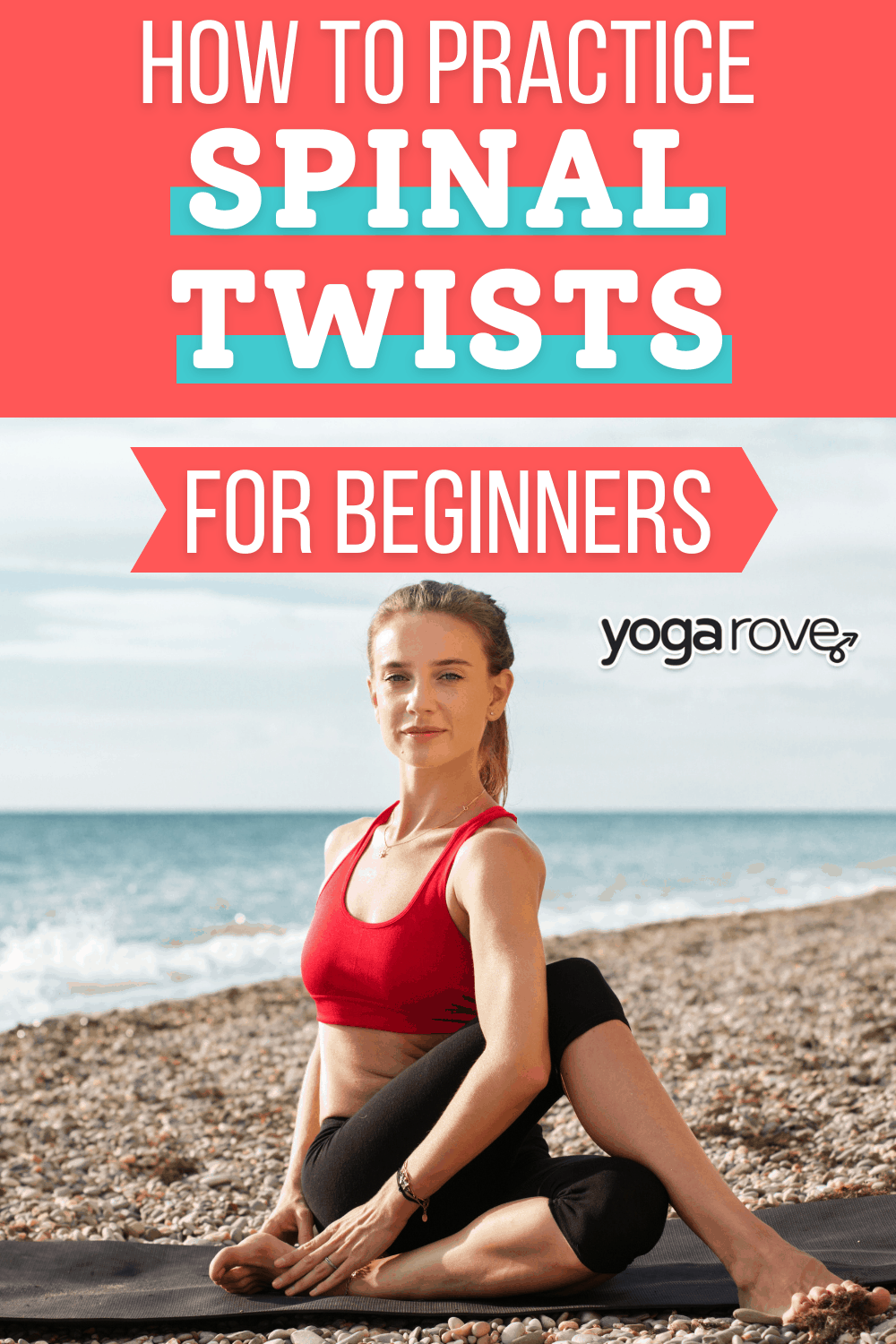
Many people practice yoga to alleviate lower back pain. Often, seated or supine twists offer a great sense of release during practice. The great thing is that this simple pose can be practiced off your mat as well. You can practice your seated spinal twist not only in your yoga class, but in your office chair, your bed, and even in a subway seat!
So what are the benefits of a seated spinal twist? There are many physical and overall wellness benefits to practicing seated spinal twists regularly. Twists are a must-do in any yoga practice. There are many different variations of seated spinal twists that anyone can practice depending on your body and your flexibility.
When Can I Practice Seated Spinal Twist?
Seated spinal twists are generally practiced in the beginning of class or towards the end of class. These gentle twists help to warm up and lengthen the spine before class. They also help to cool down and stretch out the spine and entire body at the end of practice.
A seated spinal twist is different from more dynamic twists like a chair twist or even the arm balance, Eka Pada Koundinyasana. They are more restorative and less fiery than a strong, standing posture with a twist.
There are many different twisting poses that you can practice while seated on your mat. Each seated spinal twist pose works different parts of the body and has its own unique benefits. In general, seated spinal twists aid in digestion, improves spinal mobility, and relieves lower back pain.
The Benefits of a Seated Spinal Twist
Do you ever notice that after a really good twist you feel like a million bucks? A great twist can not only increase your spinal flexibility, but it can help you to feel lighter, more open, and able to move more freely in your body. There are numerous benefits to practicing a seated spinal twist. If practiced every day, you are sure to start to see changes in your physical body.
Practicing seated spinal twists regularly will:
- Promote healthy digestion in the body
- Tone and strengthen your core
- Relieve lower back pain
- Massage your internal organs
- Improve spinal mobility
How to Practice a Seated Spinal Twist
Depending on your body, there are different variations of a seated spinal twist that you can practice. Whether you are at a yoga class, or would like to sneak in a little twist at your desk at work, here are two seated spinal twists that you can practice everyday.
Seated Spinal Twist in a Chair
This is a great twist to practice if you are commuting on a train, long-haul flight, or simply need a little pick me up at your office desk. There is no need for a mat or yoga clothes. All you need is a chair and yourself to find some lower back relief and openness in your body.
- Sit in a chair. Place both of your feet flat on the ground about hips-width distance apart.
- Straighten your spine and draw your belly button in toward your spine to engage your core.
- Place your right hand on your left knee.
- Place your left hand on the side of the chair close to your left hip. You can stay on your fingertips.
- As you inhale, lift your chest up and straighten your spine.
- As you exhale, roll your left shoulder back and twist from your spine. Feel the twist originating from your spine, and not your neck and head.
- Gently turn your head to the left. Turn your chin toward your left shoulder.
- Relax your shoulders, keep your gaze soft, and keep your spine long.
- Stay for five breaths and repeat on the opposite side.
This pose can also be practiced on your yoga mat or the floor instead of a chair. Follow the same step-by-step instructions. You can sit in either an easy cross-legged position, with your knees together and sit bones on the heels, or with your knees together sitting on a block that is placed in between the heels.
Half Lord of the Fishes Pose
Perhaps one of the most common seated spinal twists, Half Lord of the Fishes Pose is a great twist to aid in digestion and open up the spine and front side of your body.
- Sit at the back of your mat with your legs straight out in front of you.
- Bend your right knee and place the sole of your right foot outside of your left knee. You can choose to stay here and keep your left leg straight.
- Otherwise, bend your left knee and take your left heel close to your right sit bone.
- Readjust if you need to and make sure that both of your sit bones are on the floor. Check that you aren’t sitting on your left foot. Make sure that your right foot is flat on the mat with your right knee pointing up toward the ceiling.
- Place your right hand behind your body like a second spine. Place your fingertips on the mat.
- Lift your right arm up and hook your elbow against your right knee.
- As you inhale, lift and lengthen your spine. As you exhale, roll your right shoulder back and twist. Feel the twist originate from your spine and not your neck.
- Gently turn your head to the back of the room and take your chin toward your right shoulder.
- Soften your gaze, relax your shoulders, and lengthen your spine.
- Stay for 5 breaths and switch sides.
Muscles Used and Stretched in Seated Twist
Seated spinal twists often feel so great because they use and stretch many parts of the body. In a well-aligned twist, you are able to feel a nice opening in your chest, rotation of the shoulders, movement in the spine, and even a stretch in the hips or the glutes.
In your seated spinal twist, you are stretching and using the following muscles:
- Back
- Glutes
- Outer hips
- Abdominals
- Ribcage
- Shoulders
- Neck
- Chest
Mistakes Beginners Make During Seated Spinal Twist Pose
When practicing your seated spinal twist, there are some details that you want to make sure you are aware of in order to avoid injury or overstretching. It is important to make sure that you have a steady and solid foundation before your twist. This will help you to avoid any injuries or over-straining your body. There are a few common mistakes that you can make while practicing your twists including:
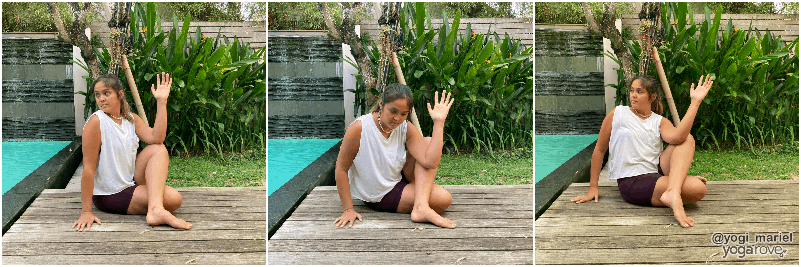
- Twisting with your neck: Your twist should come from your spine, not your neck. Oftentimes, yogis may crank their necks to look toward the back of the room thinking that they are deepening their twist. In fact, they are just straining and overstretching their neck. Make sure that your twist originates from your spine.
- Rounding your back: It is important to keep your spine nice and long when twisting. Before you start your twist, check that your spine is long, chest is broad, and your shoulders are relaxed. Bring your chin down slightly to ensure that the back of your neck is long as well.
- An unsteady foundation: Whether you are twisting on your mat or in your chair, make sure that you have a grounded and steady foundation. Your sit bones should be rooted on the chair or on your mat. If you are placing one foot on the ground, make sure that the sole of your foot is firmly rooted on the ground.
Modifications for Seated Spinal Twist
Some yogis may find seated spinal twists a little challenging especially if they are recovering from injuries or have very tight muscles. In addition, if you are pregnant, make sure that you modify your twists every time you are practicing yoga. As with every yoga pose, modify the posture according to your body and what works best for you.
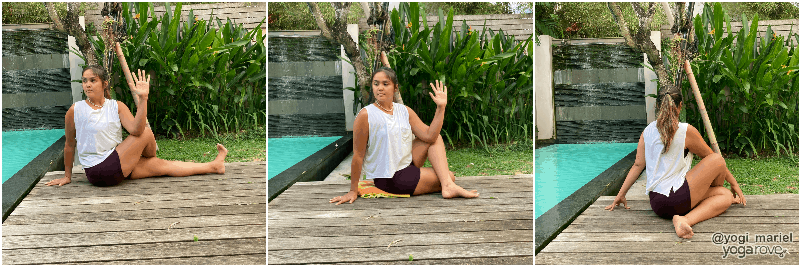
Here are some modifications for your seated spinal twist:
- If it is challenging to bend your supporting leg in Half Lord of the Fishes pose: Keep your leg straight and the heel on your mat. Flex your foot to activate the leg and twist from this solid foundation.
- If your hips are tight and or your sit bones do not feel even on the mat: You can always roll up a blanket and sit on the blanket. The extra height and support of the blanket will help you to find more space and ease in the posture.
- For pregnant ladies: Modify your twists by keeping your twists open. Instead of twisting the regular way, twist the opposite way. Keep your foundation the same and make sure that your weight is evenly distributed on the mat.
Related Questions
What is some other yoga poses with twists? There are numerous yoga poses that are not seated which involve twisting. Some of these poses are revolved triangle, extended side angle, revolved half moon, and chair twist.
How do twists improve digestion? When you twist your body, you are placing weight on your digestive organs and compressing them. This compression cuts off circulation, and when released fresh blood and nutrients are pumped back into your organs. This provides increased blood flow to the organs and improved function.
How do twists ease back pain? Twisting helps to strengthen your back muscles and release tension in your back, which in turn helps to ease chronic lower back pain.


